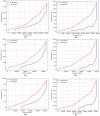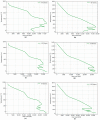Comparative Exergy and Environmental Assessment of the Residual Biomass Gasification Routes for Hydrogen and Ammonia Production
- PMID: 37510045
- PMCID: PMC10378585
- DOI: 10.3390/e25071098
Comparative Exergy and Environmental Assessment of the Residual Biomass Gasification Routes for Hydrogen and Ammonia Production
Abstract
The need to reduce the dependency of chemicals on fossil fuels has recently motivated the adoption of renewable energies in those sectors. In addition, due to a growing population, the treatment and disposition of residual biomass from agricultural processes, such as sugar cane and orange bagasse, or even from human waste, such as sewage sludge, will be a challenge for the next generation. These residual biomasses can be an attractive alternative for the production of environmentally friendly fuels and make the economy more circular and efficient. However, these raw materials have been hitherto widely used as fuel for boilers or disposed of in sanitary landfills, losing their capacity to generate other by-products in addition to contributing to the emissions of gases that promote global warming. For this reason, this work analyzes and optimizes the biomass-based routes of biochemical production (namely, hydrogen and ammonia) using the gasification of residual biomasses. Moreover, the capture of biogenic CO2 aims to reduce the environmental burden, leading to negative emissions in the overall energy system. In this context, the chemical plants were designed, modeled, and simulated using Aspen plus™ software. The energy integration and optimization were performed using the OSMOSE Lua Platform. The exergy destruction, exergy efficiency, and general balance of the CO2 emissions were evaluated. As a result, the irreversibility generated by the gasification unit has a relevant influence on the exergy efficiency of the entire plant. On the other hand, an overall negative emission balance of -5.95 kgCO2/kgH2 in the hydrogen production route and -1.615 kgCO2/kgNH3 in the ammonia production route can be achieved, thus removing from the atmosphere 0.901 tCO2/tbiomass and 1.096 tCO2/tbiomass, respectively.
Keywords: biomass gasification; bioproducts; decarbonization; energy integration; exergy analysis.
Conflict of interest statement
The authors declare no conflict of interest.
Figures















References
-
- Thraen D., Shaubach K., Global Wood Pellet Industry and Trade Study 2017 IEA Bioenergia 2017. [(accessed on 5 September 2022)]. Available online: https://www.ieabioenergy.com/blog/publications/two-page-summary-global-w...
-
- EPE Brazilian Energy Balance Year 2016. [(accessed on 2 March 2023)];2016 Available online: https://www.epe.gov.br/en/publications/publications/brazilian-energy-bal....
-
- Marcio R., Santos D., De Alencar Nääs I., Neto M.M., Vendrametto O. An overview on the brazilian orange juice production chain 1 uma visão da produção brasileira de suco de laranja. Rev. Bras. Frutic. Jaboticabal SP. 2013;35:218–255.
-
- Nakashima R., Flórez-Orrego D., de Oliveira Junior S. Integrated anaerobic digestion and gasification processes for upgrade of ethanol biorefinery residues. J. Power Technol. 2019;99:104–114.
-
- Pellegrini L.F., Deoliveirajr S. Exergy analysis of sugarcane bagasse gasification. Energy. 2007;32:314–327. doi: 10.1016/j.energy.2006.07.028. - DOI
Grants and funding
LinkOut - more resources
Full Text Sources
Research Materials

